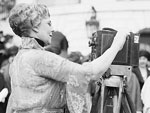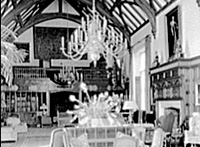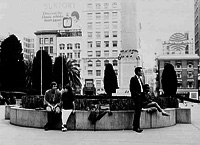African American History Month ends, and Women's History Month begins! Take a glance around the internet, and you'll find plenty of resources for teaching women's history—whether it be the Seneca Falls Convention, heroes of the American Revolution and the Civil War, social activists, First Ladies, workers during the World Wars, jazz and blues stars, or presidential candidates. You'll find photographs of many of these women, too—working in factories, on the campaign trail, helping the wounded, conducting scientific experiments.
But who takes these photographs? Who makes these images that become the records of history? Aren't the people behind the camera as significant as the ones in front of it?
Of course they are, though they can easily be forgotten. When we look at photographs of Amelia Earhart, we rarely ask who took the photo. When we're struck by a picture of New York during 9/11, do we ever ask if it was snapped by a man or a woman?
Explore women's history behind the camera this Women's History Month. What have women chosen to capture on film, as they record and live through history?
Taking Photos and Making History
- The Kansas Historical Society tells the story of Alice Gardiner Sennrich, a professional photographer early in photography's commercial history. Born in 1878, Sennrich purchased a Kansas photography studio in 1902, and ran it throughout her life, including after her marriage. Recognized by the National Association of Photographers, she was also active in the Photographers Association of Kansas (PAK), an organization that had active female members since its founding. You can hear more about Sennrich in this podcast by the Society.
- During the Great Depression, the Federal Government gave photographers, both men and women, work documenting the lives of ordinary U.S. citizens and the social conditions of the day. The Library of Congress's American Memory collection From the Great Depression to World War II: Photos from the FSA-OWI preserves more than 150,000 of these photographs. Try browsing the collections' black-and-white and color photos by creator. Look for women's names and work—and remember to check names with only a first initial and a surname! These may be women, too. Giving only a first initial was (and remains) one way to avoid being judged (at least in print) by gender.
- Photographs aren't always taken as documentation. Sometimes, they're carefully composed as art. The online archive Women Artists of the American West showcases the artwork of 19th- and 20th-century Western women. Photography exhibits include photographs by white women of Pueblo arts and crafts workers (many of them women), taken from 1900 to 1935; modern art photography by Native women; landscape photography by Laura Gilpin (1891–1979); and 1972–1997 lesbian photography (some pages contain nudity). The Women in International Photography Archive, collects essays on more than 25 women photographers.
- For an example of a modern photographer using her work as part of a political journalistic career, check out Jo Freeman.com. A writer, lawyer, and activist, Freeman's site features her photographs of Democratic and Republican conventions, marches and protests, New York after 9/11, the Chicago riot following Martin Luther King, Jr.'s assassination, and Congresswoman Shirley Chisholm's 1972 campaign for the presidency.
If photographs aren't enough, branch out into art, journalism, fiction and nonfiction writing, and other ways of recording and responding to the world, all meant for the public eye. What have women created and documented? What were their (myriad, uncountable) reasons for crafting "snapshots" and composing reactions? Women make history when they're behind its lens, as well as in front!
Further Resources
Looking for more resources? Take a quiz on women in history, with our weekly quiz archive! See how well you do on quizzes with subjects like women in the West. Search our Website Reviews, as well—we've reviewed and annotated more than 200 websites with women's history content.
If you'd still like more, these organizations feature content and pages created just for Women's History Month:


